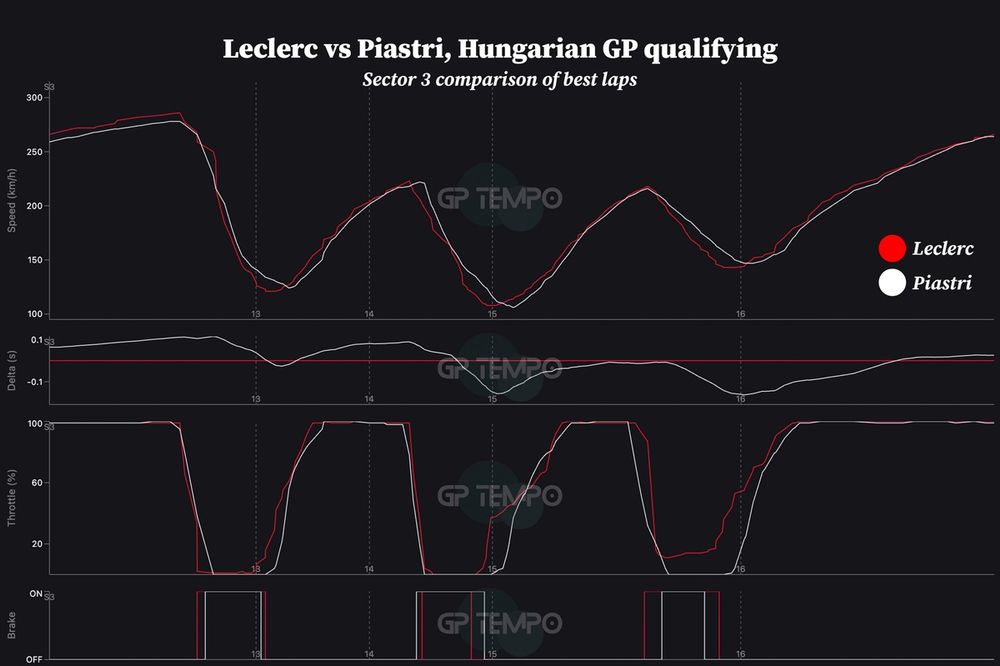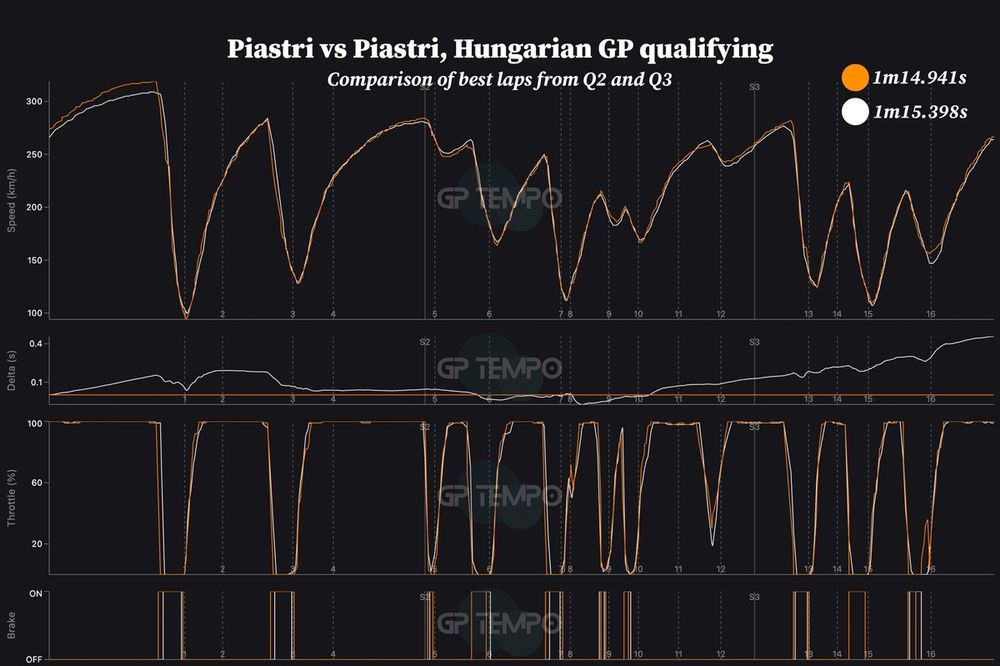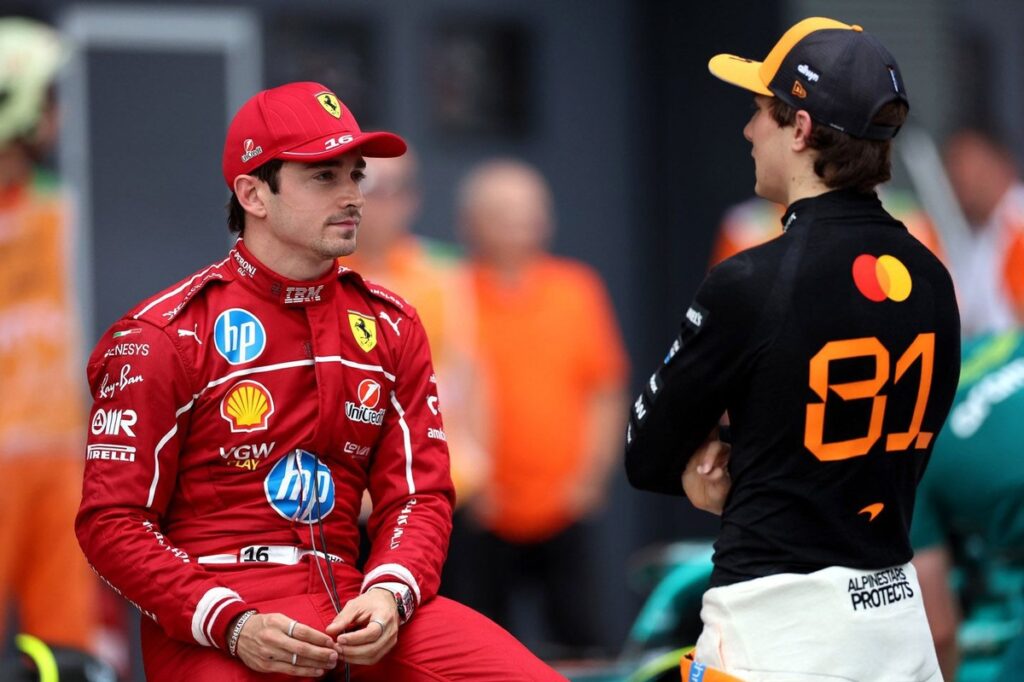If anyone was to profess to expecting anything other than McLaren domination in qualifying for the Hungarian Grand Prix, then they’re simply telling porkies; Charles Leclerc was completely blindsided by the revelation he’d secured his first Formula 1 pole of the year. He was quite content in his aim to get a clean lap banked, as the drivers felt a perceptible shift in wind direction; as it turned out, his 1m15.372s was good enough to do the job.
Sure, it was a great lap in ever-changing conditions, but his pole also came as McLaren’s pace from Q2, which dipped below the 1m15s barrier and into the realms of the 1m14s, evaporated into the Hungarian winds.
The first clue that something was truly awry was McLaren’s opening runs on fresh softs falling into the 1m15.4s, although the fact that the Oscar Piastri/Lando Norris duo still remained on top after the opening tours suggested that there was more to come. But it didn’t; the bigger clue emerged when neither driver improved on their first sector times during the second attempts.
Norris improved slightly on his second lap, which upgraded a net fifth into third, but Piastri went slower. Leclerc was audibly surprised once informed that he had the box seats for Sunday’s race.
By looking at the GPS data, we can determine where Leclerc found the time against Piastri – and there’s considerable difference here. That is because it is the championship leader’s first lap of the session and Piastri approaches the braking zones and throttle inputs very differently, as he is not yet aware of where the wind has moved. He took a lot more margin with his braking on the second attempt, which resulted in a slower lap.
Charles Leclerc, Ferrari vs Oscar Piastri, McLaren, comparison of best qualifying laps sector 1
Photo by: Motorsport Network
In the first sector, it’s all about Leclerc’s speed on the straights; he’s 7kph faster before the braking zone into Turn 1, and 10kph faster on the entry into Turn 4. This is, for want of a better technical term, strange; Leclerc had a small straightline speed benefit in their respective Q2 laps, but nothing to the same magnitude here at 2kph and 4kph into Turns 1 and 4.
In those Q2 laps, the McLaren’s engine speeds are running at about the same level during Turns 3 and 4, but Piastri is down into Turn 1 as he makes the shift up to eighth much later, so he’s about 500rpm down on his Q2 best here. Perhaps the simplest explanation is that Ferrari lost less time in the headwind into Turn 1 versus the McLaren.

Charles Leclerc, Ferrari vs Oscar Piastri, McLaren, comparison of best qualifying laps sector 2
Photo by: Motorsport Network
Piastri finds almost two tenths on Leclerc in the uphill Turn 5, and maintains an advantage through the technical part of the lap as he’s a bit more direct on the throttle travel and using less brake, while Leclerc keeps the throttle in a little bit more and course-corrects with the brake rather than a full lift. But this helps Leclerc out of Turn 9, as he brakes a touch earlier than Piastri and thus gets the drive out of the corner.
With the momentum down the hill, Leclerc converts it into an advantage at the end of the sector once more; Leclerc’s downshift to fourth, though Turn 8 again helps to keep the engine speeds up; Piastri downshifts later for Turn 9 as he comes off the throttle more, but that’s at the expense of drive out of the corner.
The gap is over a tenth in Leclerc’s favour in the braking zone for Turn 12, although Piastri finds about a hundredth on the Ferrari driver here through again using less brake. But it’s the Australian who uses more for Turn 13; and he’s had to be less cautious on the throttle as a result; now, he’s tracking at a scant 0.01s faster than Leclerc.

Charles Leclerc, Ferrari vs Oscar Piastri, McLaren, comparison of best qualifying laps sector 3
Photo by: Motorsport Network
It all culminates in the final corner exit. This is where Leclerc’s longer-braking, but keeping a touch of throttle on technique yields the better exit – on the entry to Turn 14, the drivers experience a tailwind and thus have to work harder to bleed speed out of the car, but then need the acceleration to get a jumpstart on the subsequent headwind into Turn 1. That’s where Leclerc’s previous sighter lap rewarded him with the info, while Piastri couldn’t quite get the formula right in the more wind-affected areas.
Where McLaren lost the time from Q2 to Q3
Piastri was bordering on half-a-second slower in his best Q3 lap versus his Q2 pace, and the headwind cost him a peak of 10kph into the braking zone for Turn 1. Thus, there’s a tailwind out of the corner; it doesn’t help Piastri down the straight per se, but it does give him a little push through Turn 2 and means he’s just 0.045s off his Q2 lap.
McLaren naturally possessed less pace through sector one, perhaps seeking to keep the tyres in for the second half of the lap. There are, however, clear moments where Piastri is quicker in his Q3 lap through the second sector, particularly through Turn 5 and through the subsequent chicane.

Oscar Piastri, McLaren, comparison Qualifying laps Q2 and Q3
Photo by: Motorsport Network
But the lap tails off from here, as the car is much less willing to go on-throttle and he’s chasing the rear end at this point, attempting late stabs on the brakes to stabilise.
What you then see is a pretty linear loss of time through the lap as the wind upsets the balance, and the need to take the final corner with about 10kph less through-corner speed is the final kicker as he has to brake for longer to keep the rear stable.
In this article
Be the first to know and subscribe for real-time news email updates on these topics
Read the full article here

